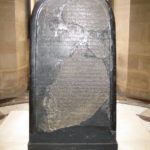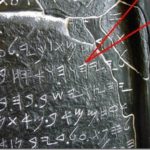The Stela of Mesha: building inscription from ancient Moab (modern day Jordan), famous because it describes events from the history of Israel that are also described in the Bible. The stone was discovered intact by Frederick Augustus Klein, an Anglican missionary, at the site ancient Dibon (now Dhiban, Jordan), in August 1868, having been led to it by a local bedouin.
In the first half of the ninth century BCE, Israel was a mighty kingdom. Its King Omri (884-873) owned at least two thousand chariots and even king Šalmaneser of Assyria admitted that Israel was a powerful enemy. Omri’s son Ahab (873-852) brought the kingdom to even greater prominence.
However, king Hazael of Aram-Damascus defeated Ahab’s son Jehoram, and a general named Jehu overthrew the dynasty of Omri. There is archaeological evidence that part of the kingdom’s heartland was even occupied by Aramaean troops. At the same time, Moab, a vassal state of Israel, broke away from Israelite overlordship. Israel’s fortunes were restored when the Assyrians attacked Aram-Damascus in 842, but Moab was lost.
The story is told in the Bible (2 Kings 1.1, 3.4-27), and was more or less confirmed by a Moabite inscription that was discovered by a German missionary in 1868 in Dhiban, the ancient Moabite capital Dibon. It records the building of Karchoh, which appears to have been a fortified quarter in the city. This was not without importance, because in the nineteenth century, many scholars had started to doubt the reliability of the Bible as source for ancient history. The stela in which king Mesha offers his view on the war against Israel was seen as an important argument against these skeptics.
To some extent, the inscription offers few surprises. The author of 2 Kings claims considerable Israelite successes; the Moabite king Mesha makes the same claim. His victory, he says, is the result of support from the national god Kemoš, which was not a strange theological idea. The inscription also contained a reference to YHWH; until now, this is the earliest occurrence of the name of the god in an inscription.


